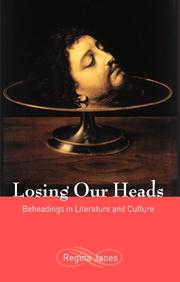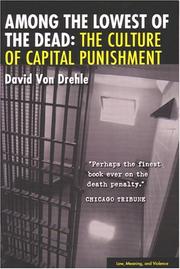| Listing 1 - 10 of 84 | << page >> |
Sort by
|
Book
ISBN: 1476617155 9781476617152 9780786495399 0786495391 Year: 2015 Publisher: Jefferson, North Carolina : McFarland & Company, Inc., Publishers,
Abstract | Keywords | Export | Availability | Bookmark
 Loading...
Loading...Choose an application
- Reference Manager
- EndNote
- RefWorks (Direct export to RefWorks)
"Presented in chronological order, this book provides essential details about the 1,152 men and women who were legally put to death in North and South Carolina during the century after the Civil War. Each entry contains information about the criminals themselves and the deeds which cost them their lives"--
Book
ISBN: 1476620008 9781476620008 9780786498697 0786498692 Year: 2016 Publisher: Jefferson, North Carolina : McFarland & Company, Inc., Publishers,
Abstract | Keywords | Export | Availability | Bookmark
 Loading...
Loading...Choose an application
- Reference Manager
- EndNote
- RefWorks (Direct export to RefWorks)
Book
ISBN: 1476618259 9781476618258 9780786495405 0786495405 Year: 2015 Publisher: Jefferson, North Carolina : McFarland & Company, Inc., Publishers,
Abstract | Keywords | Export | Availability | Bookmark
 Loading...
Loading...Choose an application
- Reference Manager
- EndNote
- RefWorks (Direct export to RefWorks)
In the century following the Civil War, Delaware, the District of Columbia, Maryland, Virginia and West Virginia legally executed hundreds of men and women convicted of capital crimes. Based on exhaustive research of court records, newspapers death certificates and even gravestones, this book provides the essential details of each case. Arranged by state, entries for each execution are listed in chronological order, giving the name, race and age of the prisoner and a description of the crime of which he or she was convicted. The motive, if known, the date and place of the execution
Book
ISBN: 1476620016 9781476620015 9780786498703 0786498706 Year: 2016 Publisher: Jefferson, North Carolina : McFarland & Company, Incorporated, Publishers,
Abstract | Keywords | Export | Availability | Bookmark
 Loading...
Loading...Choose an application
- Reference Manager
- EndNote
- RefWorks (Direct export to RefWorks)
Book
ISBN: 1848585128 9781848585126 Year: 2006 Publisher: Arcturus
Abstract | Keywords | Export | Availability | Bookmark
 Loading...
Loading...Choose an application
- Reference Manager
- EndNote
- RefWorks (Direct export to RefWorks)
Societies throughout history have adopted many and varied methods of meting out the ultimate sanction of capital punishment to their more unruly members.Although a number of countries across the globe still execute their own citizens, on occasion in public, the modern world in general views execution with distaste, and public execution doubly so. Public Executions documents the phenomenon of state-sanctioned killing from the ancient world to modern times, and in doing so, shows that although we regard the ancient practices with horror, they would have been equally bemused by our modern scruples, and would have regarded execution behind closed doors as little short of murder.Public Executions is a gruesomely enthralling account of public executions down through the ages and from around the world.
Public executions --- History. --- Executions and executioners
Book
ISBN: 1283636689 0826348580 9780826348586 9780826348562 0826348564 Year: 2010 Publisher: Albuquerque : University of New Mexico Press,
Abstract | Keywords | Export | Availability | Bookmark
 Loading...
Loading...Choose an application
- Reference Manager
- EndNote
- RefWorks (Direct export to RefWorks)
These original essays examine the complex history of the death penalty, focusing on specific geographic areas to illuminate the circumstances of law and politics.
Capital punishment --- Executions and executioners --- History. --- States.

ISBN: 0814743617 9780814743614 9780814742693 0814742696 9780814742709 081474270X Year: 2005 Publisher: New York, NY : New York University Press,
Abstract | Keywords | Export | Availability | Bookmark
 Loading...
Loading...Choose an application
- Reference Manager
- EndNote
- RefWorks (Direct export to RefWorks)
What is the fascination that decollation holds for us, as individuals and as a culture? Why does the idea make us laugh and the act make us close our eyes? Losing Our Heads explores in both artistic and cultural contexts the role of the chopped-off head. It asks why the practice of decapitation was once so widespread, why it has diminished—but not, as scenes from contemporary Iraq show, completely disappeared—and why we find it so peculiarly repulsive that we use it as a principal marker to separate ourselves from a more “barbaric”or “primitive” past? Although the topic is grim, Regina Janes’s treatment and conclusions are neither grisly nor gruesome, but continuously instructive about the ironies of humanity’s cultural nature. Bringing to bear an array of evidence, the book argues that the human ability to create meaning from the body motivates the practice of decapitation, its diminution, the impossibility of its extirpation, and its continuing fascination. Ranging from antiquity to the late nineteenth-century passion for Salomé and John the Baptist, and from the enlightenment to postcolonial Africa’s challenge to the severed head as sign of barbarism, Losing Our Heads opens new areas of investigation, enabling readers to understand the shock of decapitation and to see the value in moving past shock to analysis. Written with penetrating wit and featuring striking illustrations, it is sure to captivate anyone interested in his or her head.
Executions and executioners in art. --- Beheading in literature. --- Beheading --- Decapitation --- Executions and executioners --- History.

ISBN: 0394462718 Year: 1971 Publisher: New York Random House
Abstract | Keywords | Export | Availability | Bookmark
 Loading...
Loading...Choose an application
- Reference Manager
- EndNote
- RefWorks (Direct export to RefWorks)
Executions and executioners --- Jewish families --- Jews --- Trials (Espionage) --- Fiction. --- Fiction

ISBN: 1282644661 9786612644665 0472026984 9780472026982 9781282644663 0472031236 9780472031238 Year: 2006 Publisher: Ann Arbor, Mich. : University of Michigan Press,
Abstract | Keywords | Export | Availability | Bookmark
 Loading...
Loading...Choose an application
- Reference Manager
- EndNote
- RefWorks (Direct export to RefWorks)
Executions and executioners --- Death row --- Death row inmates
Book
ISBN: 0774817550 9786613335487 1283335484 9780774817554 9781283335485 9780774817530 0774817534 0774817542 9780774817547 Year: 2010 Publisher: Vancouver UBC Press
Abstract | Keywords | Export | Availability | Bookmark
 Loading...
Loading...Choose an application
- Reference Manager
- EndNote
- RefWorks (Direct export to RefWorks)
It is easy to forget that the death penalty was an accepted aspect of Canadian culture and criminal justice from Confederation until 1976. The Practice of Execution in Canada is not about what led some to the gallows and others to escape it. Rather, it examines how the routine rituals and practices of education can be seen as a crucial social institution. Drawing on hundreds of case files, Ken Leyton-Brown shows that from trial to interment, the practice of execution was constrained by law and tradition.Despite this, however, the institution was not rigid. Criticism and reform pushed executions out of the public eye, and in so doing, stripped them of meaningful ritual and made them more vulnerable to criticism. Comprehensive and absorbing, this groundbreaking study is for anyone who wants a deeper understanding of contemporary debates on capital punishment.
Executions and executioners --- Capital punishment --- History. --- Social aspects
| Listing 1 - 10 of 84 | << page >> |
Sort by
|

 Search
Search Feedback
Feedback About UniCat
About UniCat  Help
Help News
News